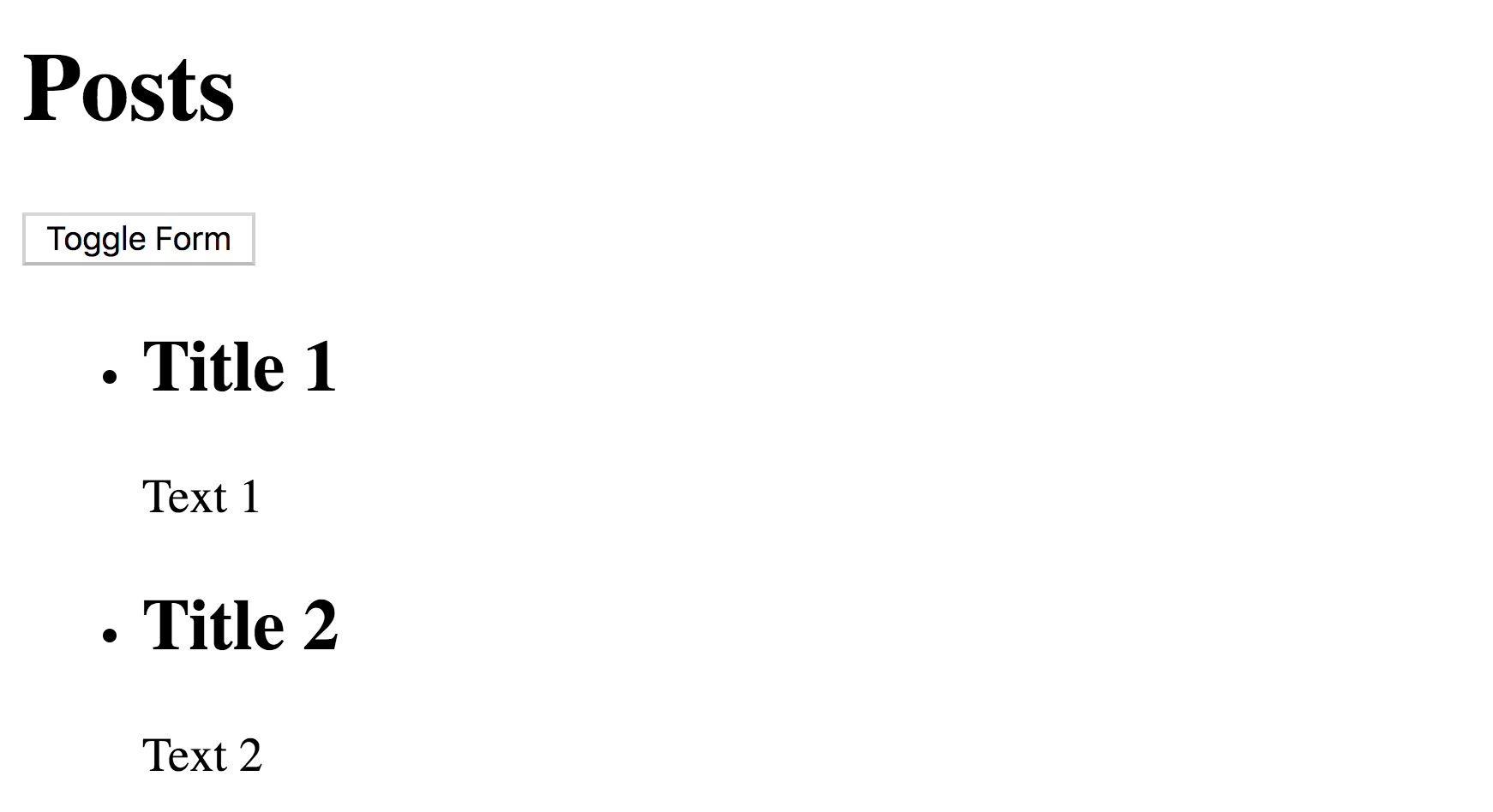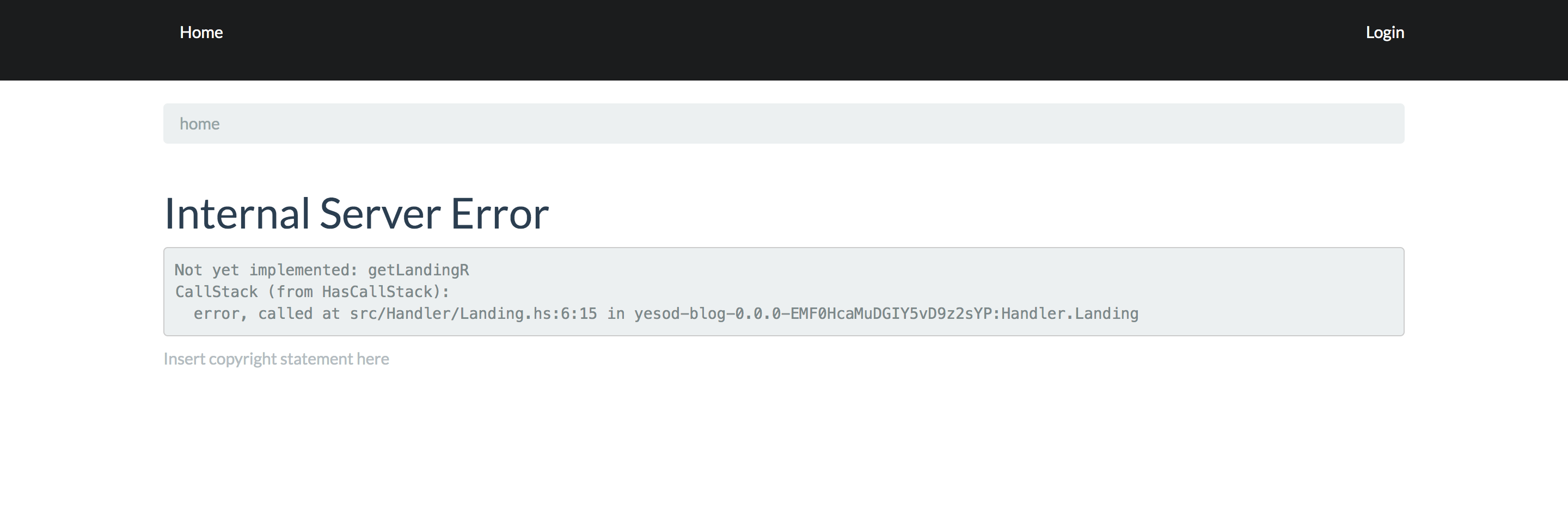This is a series about Yesod: a Haskell web framework that follows a similar philosophy to Rails. In fact, it is strongly opinionated and provides a lot of functionality out of the box.
A good read about Yesod is available online for free: Developing web applications with Haskell and Yesod. That's why this series will be a commentary of the commits from a repo we will use to develop a super simple blog.
In other words, this won't be good material to learn how to use Yesod. However, it will hopefully give an overview of how the framework works.
Intro
In this post we are going to develop the basic structure of our blog. The flow of the user is simple:
- The landing page is a login form:

- After a successful login the user is redirected to the posts page. Here, the user is able to create a new post and check all the posts already published:

To keep this article simple, we are not going to connect to the database, neither we will check the login credentials.
Init
Commit 7a5782d47e082a8cfcb4e07bac71d88709179c0c just implements the steps listed in the Yesod quick start guide.
The Landing Page
The stack exec -- yesod add-handler command allows to create a new route and handler. In other words, the logic that takes care of a request at a specific URL.
Commit 354fac670be4b9869b171a0fdd7d15063d094fdb uses that command to add the landing page route
diff --git a/config/routes b/config/routes
index 37e8bea..df5e055 100644
--- a/config/routes
+++ b/config/routes
@@ -12,3 +12,4 @@
/comments CommentR POST
/profile ProfileR GET
+/landing LandingR GET
and handler:
diff --git a/src/Handler/Landing.hs b/src/Handler/Landing.hs
new file mode 100644
index 0000000..8a1fbdc
--- /dev/null
+++ b/src/Handler/Landing.hs
@@ -0,0 +1,6 @@
+module Handler.Landing where
+
+import Import
+
+getLandingR :: Handler Html
+getLandingR = error "Not yet implemented: getLandingR"
Authorization
Yesod provides authentication / authorization support out of the box. That is why the application doesn't compile:
Pattern match(es) are non-exhaustive
In an equation for ‘isAuthorized’: Patterns not matched: LandingR _
|
163 | isAuthorized (AuthR _) _ = return Authorized
| ^^^^^^^^^^^^^^^^^^^^^^^^^^^^^^^^^^^^^^^^^^^^...
In particular, we are missing isAuthorized for the new LandingR handler. Let's fix it by always allowing access:
diff --git a/src/Foundation.hs b/src/Foundation.hs
index f91122a..011e171 100644
--- a/src/Foundation.hs
+++ b/src/Foundation.hs
@@ -171,6 +171,8 @@ instance Yesod App where
-- delegate to that function
isAuthorized ProfileR _ = isAuthenticated
+ isAuthorized LandingR _ = return Authorized
+
-- This function creates static content files in the static folder
-- and names them based on a hash of their content. This allows
-- expiration dates to be set far in the future without worry of
With that, it's possible to launch the dev server stack exec -- yesod devel and visit /landing.

The error comes from the fact that the handler is not yet developed.
Landing Somewhere
In the spirit of doing baby steps, let's first put something on screen for /landing. Commit 5271b5f514782f659c89101ee0c1cd4f8d691ade introduces an Hamlet template which is used to generate HTML:
diff --git a/templates/landing.hamlet b/templates/landing.hamlet
new file mode 100644
index 0000000..af3d162
--- /dev/null
+++ b/templates/landing.hamlet
@@ -0,0 +1,2 @@
+<h1>
+ Landing #{interpolated}
In particular, #{interpolated} comes from the handler:
diff --git a/src/Handler/Landing.hs b/src/Handler/Landing.hs
index 8a1fbdc..aefaa65 100644
--- a/src/Handler/Landing.hs
+++ b/src/Handler/Landing.hs
@@ -1,6 +1,15 @@
+{-# LANGUAGE NoImplicitPrelude #-}
+{-# LANGUAGE OverloadedStrings #-}
+{-# LANGUAGE TemplateHaskell #-}
+{-# LANGUAGE MultiParamTypeClasses #-}
+{-# LANGUAGE TypeFamilies #-}
+
module Handler.Landing where
import Import
getLandingR :: Handler Html
-getLandingR = error "Not yet implemented: getLandingR"
+getLandingR = do
+ defaultLayout $ do
+ let interpolated = "interpolated string" :: Text
+ $(widgetFile "landing")
In other words, every variable in scope can be used in the template.
If we visited /landing now we would see: 
Tweaking the Landing
Commit bb89035c9e4f4b9265bebe378ec38e932bc47bcd does a couple of things:
- Puts the
LandingRhandler at/:
diff --git a/config/routes b/config/routes
index df5e055..c2d4fd2 100644
--- a/config/routes
+++ b/config/routes
@@ -7,9 +7,9 @@
/favicon.ico FaviconR GET
/robots.txt RobotsR GET
-/ HomeR GET POST
+/home HomeR GET POST
/comments CommentR POST
/profile ProfileR GET
-/landing LandingR GET
+/ LandingR GET
- Creates an
emptyLayout. This is done to remove all the noise created while initializing the Yesod application so that the code is easier to navigate. We won't get into details, the important thing is that we can now useemptyLayoutinstead ofdefaultLayout.
diff --git a/src/Handler/Landing.hs b/src/Handler/Landing.hs
index aefaa65..7675a0f 100644
--- a/src/Handler/Landing.hs
+++ b/src/Handler/Landing.hs
@@ -7,9 +7,15 @@
module Handler.Landing where
import Import
+import Text.Hamlet (hamletFile)
+
+emptyLayout :: Widget -> Handler Html
+emptyLayout widget = do
+ pc <- widgetToPageContent $ do
+ $(widgetFile "empty-layout")
+ withUrlRenderer $(hamletFile "templates/empty-layout-wrapper.hamlet")
getLandingR :: Handler Html
getLandingR = do
- defaultLayout $ do
- let interpolated = "interpolated string" :: Text
+ emptyLayout $ do
$(widgetFile "landing")
diff --git a/templates/empty-layout-wrapper.hamlet b/templates/empty-layout-wrapper.hamlet
new file mode 100644
index 0000000..18bb787
--- /dev/null
+++ b/templates/empty-layout-wrapper.hamlet
@@ -0,0 +1,5 @@
+\<!doctype html>
+<html>
+ <head>
+ <body>
+ ^{pageBody pc}
diff --git a/templates/empty-layout.hamlet b/templates/empty-layout.hamlet
new file mode 100644
index 0000000..42cfe82
--- /dev/null
+++ b/templates/empty-layout.hamlet
@@ -0,0 +1,2 @@
+<div .container>
+ ^{widget}
Also, we get ready to add the login form:
diff --git a/templates/landing.hamlet b/templates/landing.hamlet
index af3d162..24a77b3 100644
--- a/templates/landing.hamlet
+++ b/templates/landing.hamlet
@@ -1,2 +1 @@
-<h1>
- Landing #{interpolated}
+<h1>Login
If we visited / now we would see just a "Login" heading.
The Login Form
Commit 8d89a7101a979b06ea324c8d6d9aa0373f49d6ee adds the login form logic.
In particular, we first add the posts route and handler with stack exec -- yesod add-handler. This will be the page to redirect too after a successful login. Also, we add a POST handler to LandingR to handle the form submit:
diff --git a/config/routes b/config/routes
index c2d4fd2..db4ac58 100644
--- a/config/routes
+++ b/config/routes
@@ -12,4 +12,5 @@
/comments CommentR POST
/profile ProfileR GET
-/ LandingR GET
+/ LandingR GET POST
+/posts PostsR GET
Then we allow anybody to access PostR. We will limit this resource to logged in users in the future.
diff --git a/src/Application.hs b/src/Application.hs
index 99dbb26..6045a41 100644
--- a/src/Application.hs
+++ b/src/Application.hs
@@ -45,6 +45,7 @@ import Handler.Home
import Handler.Comment
import Handler.Profile
import Handler.Landing
+import Handler.Posts
-- This line actually creates our YesodDispatch instance. It is the second half
-- of the call to mkYesodData which occurs in Foundation.hs. Please see the
diff --git a/src/Foundation.hs b/src/Foundation.hs
index 011e171..e96228a 100644
--- a/src/Foundation.hs
+++ b/src/Foundation.hs
@@ -173,6 +173,8 @@ instance Yesod App where
isAuthorized LandingR _ = return Authorized
+ isAuthorized PostsR _ = return Authorized
+
We add the login form. Important pieces here:
- The type-safe url
@{LandingR}: the form gets submitted to the POSTLandingRhandler - The interpolated form
^{widget}that comes from the GETLandingRhandler
diff --git a/templates/landing.hamlet b/templates/landing.hamlet
index 24a77b3..8df39e9 100644
--- a/templates/landing.hamlet
+++ b/templates/landing.hamlet
@@ -1 +1,4 @@
<h1>Login
+<form method=post action=@{LandingR} enctype=#{enctype}>
+ ^{widget}
+ <button>Login
The form gets generated in the GET LandingR handler using generateFormPost. In other words, a form that will be submitted via POST.
Subsequently, POST LandingR handler takes the submitted form parameters and runs the validation with runFormPost. In case of success, the user is redirected to the posts page. Otherwise, the login page is re-rendered with the validation errors.
diff --git a/src/Handler/Landing.hs b/src/Handler/Landing.hs
index 7675a0f..c2d4d10 100644
--- a/src/Handler/Landing.hs
+++ b/src/Handler/Landing.hs
@@ -3,19 +3,33 @@
{-# LANGUAGE TemplateHaskell #-}
{-# LANGUAGE MultiParamTypeClasses #-}
{-# LANGUAGE TypeFamilies #-}
+{-# LANGUAGE OverloadedStrings #-}
module Handler.Landing where
import Import
+data Login =
+ Login { username :: Text, password :: Text }
+ deriving Show
+
+loginForm :: Form Login
+loginForm =
+ renderDivs $
+ Login <$> areq textField "Username" Nothing <*> areq textField "Password" Nothing
getLandingR :: Handler Html
getLandingR = do
+ (widget, enctype) <- generateFormPost loginForm
emptyLayout $ do
$(widgetFile "landing")
+
+postLandingR :: Handler Html
+postLandingR = do
+ ((result, widget), enctype) <- runFormPost loginForm
+ case result of
+ FormSuccess _ ->
+ redirect PostsR
+ _ ->
+ emptyLayout $ do
+ $(widgetFile "landing")
If we visited / now we would see: 
The Posts Page
Since the posts page was created with stack exec -- yesod add-handler, it only has an empty handler:
diff --git a/src/Handler/Posts.hs b/src/Handler/Posts.hs
new file mode 100644
index 0000000..138f43b
--- /dev/null
+++ b/src/Handler/Posts.hs
@@ -0,0 +1,6 @@
+module Handler.Posts where
+
+import Import
+
+getPostsR :: Handler Html
+getPostsR = error "Not yet implemented: getPostsR"
Commit a176ea0d10b63b9613cbfc5bbf86fbe264461111 fixes it by tweaking the posts page. In particular, it adds a couple of hardcoded posts and a form to create a new one.
The structure is exactly the same as seen above for the login page:
diff --git a/config/routes b/config/routes
index db4ac58..5a01ba2 100644
--- a/config/routes
+++ b/config/routes
@@ -13,4 +13,4 @@
/profile ProfileR GET
/ LandingR GET POST
-/posts PostsR GET
+/posts PostsR GET POST
diff --git a/src/Handler/Posts.hs b/src/Handler/Posts.hs
index 138f43b..8d0b8c4 100644
--- a/src/Handler/Posts.hs
+++ b/src/Handler/Posts.hs
@@ -1,6 +1,35 @@
+{-# LANGUAGE NoImplicitPrelude #-}
+{-# LANGUAGE OverloadedStrings #-}
+{-# LANGUAGE TemplateHaskell #-}
+{-# LANGUAGE MultiParamTypeClasses #-}
+{-# LANGUAGE TypeFamilies #-}
+{-# LANGUAGE OverloadedStrings #-}
+
module Handler.Posts where
import Import
+data Post =
+ Post { title :: Text, text :: Text }
+ deriving Show
+
+postForm :: Form Post
+postForm =
+ renderDivs $
+ Post <$> areq textField "Title" Nothing <*> areq textField "Text" Nothing
+
getPostsR :: Handler Html
-getPostsR = error "Not yet implemented: getPostsR"
+getPostsR = do
+ (widget, enctype) <- generateFormPost postForm
+ emptyLayout $ do
+ $(widgetFile "posts")
+
+postPostsR :: Handler Html
+postPostsR = do
+ ((result, widget), enctype) <- runFormPost postForm
+ case result of
+ FormSuccess _ ->
+ redirect PostsR
+ _ ->
+ emptyLayout $ do
+ $(widgetFile "posts")
diff --git a/templates/posts.hamlet b/templates/posts.hamlet
new file mode 100644
index 0000000..2445442
--- /dev/null
+++ b/templates/posts.hamlet
@@ -0,0 +1,15 @@
+<h1>Posts
+
+<div id="new-post">
+ <form method=post action=@{PostsR} enctype=#{enctype}>
+ ^{widget}
+ <button>Post
+
+<ul>
+ <li>
+ <h2>Title 1
+ <p>Text 1
+
+ <li>
+ <h2>Title 2
+ <p>Text 2
If we visited /posts now we would see: 
Tweaking the Empty Layout
Commit 77567ed74b12685bbf319a6764f1ff83ac9604b8 adds an important element to the empty layout. We won't get into details but it is going to be important later when adding CSS.
diff --git a/templates/empty-layout-wrapper.hamlet b/templates/empty-layout-wrapper.hamlet
index 18bb787..c98c0a0 100644
--- a/templates/empty-layout-wrapper.hamlet
+++ b/templates/empty-layout-wrapper.hamlet
@@ -1,5 +1,6 @@
\<!doctype html>
<html>
<head>
+ ^{pageHead pc}
<body>
^{pageBody pc}
Adding JavaScript and CSS to Posts
Commit 5fb4b964e0890a042b868738d32a99680c06836e shows how to add JavaScript and CSS to a template.
Up until now, we've been using $(widgetFile "NAME") to render Hamlet templates. Turns out the widgetFile looks for other types of templates and puts them together. In fact, by using Julius and Cassius templates we can add respectively JavaScript and CSS.
The following change introduces a button that allows to show / hide the post form with a button:
diff --git a/templates/posts.cassius b/templates/posts.cassius
new file mode 100644
index 0000000..f16f327
--- /dev/null
+++ b/templates/posts.cassius
@@ -0,0 +1,2 @@
+#new-post
+ display: none
diff --git a/templates/posts.hamlet b/templates/posts.hamlet
index 2445442..82e717c 100644
--- a/templates/posts.hamlet
+++ b/templates/posts.hamlet
@@ -1,5 +1,8 @@
<h1>Posts
+<button id="toggle-new-post">
+ Toggle Form
+
<div id="new-post">
<form method=post action=@{PostsR} enctype=#{enctype}>
^{widget}
diff --git a/templates/posts.julius b/templates/posts.julius
new file mode 100644
index 0000000..3790b61
--- /dev/null
+++ b/templates/posts.julius
@@ -0,0 +1,10 @@
+document.addEventListener("DOMContentLoaded", function() {
+ document.getElementById("toggle-new-post").addEventListener("click", function() {
+ var value =
+ document.getElementById("new-post").style.display === "block"
+ ? "none"
+ : "block";
+
+ document.getElementById("new-post").style.display = value;
+ });
+});
If we visited / now we would see: 
